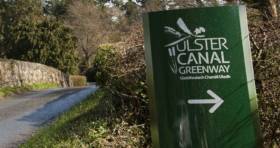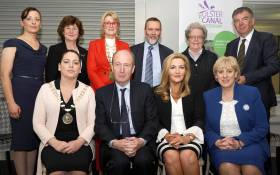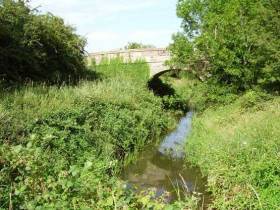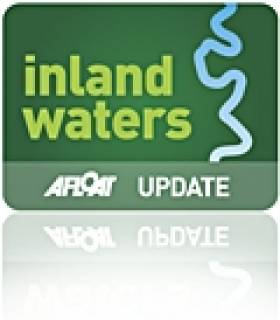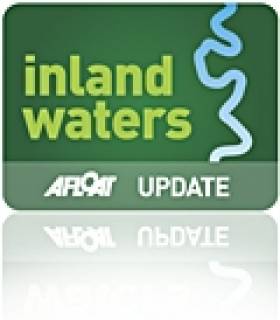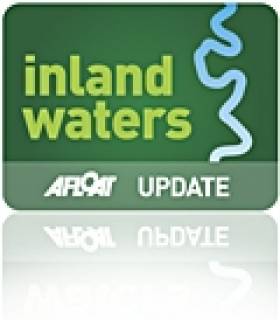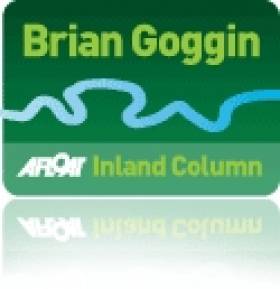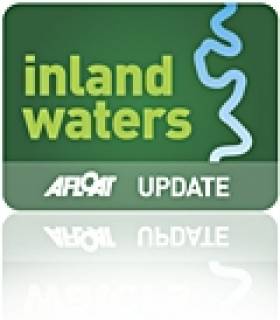Displaying items by tag: Ulster Canal
#InlandWaters - A series of three ‘community information events’ on the next phase of the Ulster Canal Greenway begins this week, with a meeting at Tyholland Community Centre in Co Monaghan from 4pm to 8pm tomorrow (Tuesday 2 October).
This will be followed by events at Middletown Community Parish Hall, Co Armagh on Wednesday 10 October, and Smithborough Community Hall, Co Monaghan on Thursday 18 October, both also from 4pm to 8pm.
Waterways Ireland; Monaghan County Council; Armagh City, Banbridge and Craigavon Borough Council; and East Border Region Ltd are working in partnership to deliver Phase 2 of the Ulster Canal Greenway.
Landowners, local communities and the general public are invited to these information events to find out more about the project.
EU-Funded €4.95m Ulster Canal Greenway Project is Launched
The Minister for Transport, Tourism and Sport, Shane Ross TD and the Minister for Culture, Heritage and the Gaeltacht, Heather Humphreys TD, have today launched the EU-funded €4.95m Ulster Canal Greenway Project which will see the development of an off-road sustainable travel route between Smithborough, Co Monaghan and Middletown, Co Armagh.
The project is supported by the European Union's INTERREG VA Programme, managed by the Special EU Programmes Body (SEUPB). The project is also supported by the Department of Transport, Tourism and Sport in Ireland and the Department for Infrastructure in Northern Ireland. The project partners, led by Waterways Ireland, are Monaghan County Council, Armagh City, Banbridge & Craigavon Borough Council and East Border Region Ltd.
Minister Ross stated “This is a wonderful initiative. Greenways connect communities, promote healthier lifestyles and encourage engagement with the outdoors. They also offer active travel opportunities for both pedestrians and cyclists and have proven to be a major attraction for visitors.
I’m very pleased to be launching Phase 2 of the Ulster Canal Greenway here today. Creating a new Greenway involves years of planning, construction and goodwill from those in surrounding lands. But it’s a commitment that delivers back to the community in spades. This Greenway promises to be a major asset to surrounding areas, as it brings the old towpaths of the disused Ulster Canal back into use and extends the Monaghan Town Greenway by 22km in a very welcome cross-border project. By 2020, the Greenway will link Smithborough, Co Monaghan to Middleton, Co Armagh.
I very much look forward to making use of it in the future and I encourage you all to do likewise.”
The Ulster Canal Greenway (UCG) Phase 2 project is a pioneering move to develop the first sustainable transport alternative for cross-border commuters between Smithborough, Co. Monaghan and Middletown, Co. Armagh. Monaghan to Northern Ireland is the second highest of all South-North commuter flows, and Armagh to Ireland is the third highest of all North-South flows. The project valued at €4.95m aims to construct 22km of new cross-border Greenway by 2020 and actively to promote commuter behavioural change through a targeted community engagement programme. It will result in a 4.5% increase in the number of cross-border journeys via walking / cycling by 2023. The project is designed to connect with the completed Phase I section, which utilises the disused Ulster Canal to provide a highly strategic route linking the east/ west sides of Monaghan.
Minister Heather Humphreys in whose constituency the Greenway will run, said at the launch
“I am delighted that Waterways Ireland, an agency under the remit of my own Department, have agreed to act as the lead partner for this flagship cross-border project. The first phase of the Greenway, here in Monaghan, already attracts over 100,000 users per year and has been a fantastic success since it opened in 2014. The further expansion of the Greenway will strengthen cross border relations by directly linking communities North and South of the border. The provision of this landmark recreational amenity will also provide a huge tourism boost for County Monaghan and the wider border region. “
Speaking at the event Gina McIntyre, Chief Executive Officer with the Special EU Programmes Body, said: “When completed this cross border project will help to meet some important targets under the sustainable transport objective of the EU’s INTERREG VA Programme. It will encourage more people to get out of their cars and increase the number of cross-border journeys made by walking and cycling, thereby helping to reduce our collective carbon footprint.
“Not only will this produce many benefits for the region, but the project is also making a contribution towards the EU’s ‘Europe 2020’ strategy which has been specifically designed to reduce greenhouse gas emissions and help safeguard the environment,” she continued.
Also attending the launch on the day were children from St John’s Primary School, Middletown, Co Armagh and Gaelscoil Ultain, St Marys Boys School and St Louis Girls School The extended Ulster Canal Greenway route will create the first cross-border greenway that will enable cyclists and walkers commute to work and study in future years.
The Cathaoirleach of Monaghan County Council Cllr Cathy Bennett stated ‘The 4km Monaghan Town Greenway has been a huge success and it attracts over 100,000 users annually. I am delighted that the INTERREG VA programme is supporting the next 22km section of the Ulster Canal Greenway. This new phase of the greenway will join communities north and south of the border, bringing huge benefits to our area and encouraging even more people to get out walking and cycling on a daily basis.’
Alderman Elizabeth Ingram, Armagh City, Banbridge & Craigavon Borough Council stated "A key facet of our vision is to engage and support initiatives that protect and safeguard our environment for future generations to come that is why we are delighted to partner up on the EU funded Ulster Canal Greenway project. Bringing about substantial environmental benefits whilst enhancing the quality of life in the area, this pioneering project will deliver an alternative and sustainable pathway for cyclists and walkers to commute between both sides of the border. The collaborative project highlights our commitment to growing a connected, welcoming and healthy community.”
The project will also contribute to a deepened level of partnership between key stakeholders and to the development of expertise and dissemination of best practice in delivering cross-border projects.
Waterways Ireland, and their project partners Monaghan County Council, Cavan County Council, Fermanagh & Omagh District Council and Armagh City, Banbridge & Craigavon Borough Council, propose to develop a long-distance Greenway in Northern Ireland and the Republic of Ireland, linking Castle Saunderson in County Cavan to Charlemont in County Armagh mainly along the route of the disused Ulster Canal and using sections of disused railway infrastructure. The proposals for development of these greenway sections are provided within the Ulster Canal Greenway Development Strategy which is now open for public view and feedback.
The draft Ulster Canal Greenway Development Strategy and associated environmental reports will be available for public consultation from the 28th April 2017 until the 21st July 2017. As part of this public consultation there will be four public information events held, which will demonstrate the proposed greenway routes, with cross sections, related imagery, and interactive mapping available. The public information events are as follows:
Monday 8th May, 3pm - 8pm - Courtyard Room, Newtownbutler Community Hall, Co Fermanagh.
Tuesday 9th May, 3pm - 8pm - Market House in Monaghan Town, Co Monaghan
Wednesday 10th May, 3-8pm - Seven Horseshoes, Belturbet, Co Cavan
Comments and feedback on the draft Ulster Canal Greenway Development Strategy and associated environmental reports are welcome on or before July 21, 2017. Draft documents are available for inspection at the project partner offices and websites including www.waterwaysireland.org. Feedback on the proposals and reports should be sent either by email to [email protected]; or by post to Ulster Canal Greenway Development Strategy, Cormac McCarthy, Environment & Heritage Section, Waterways Ireland, Dock Road, Drewsborough, Scarriff, Co. Clare, Ireland.
Restoration of Ulster Canal Proves A Technical Challenge
The Minister for Arts, Heritage, Regional, Rural and Gaeltacht Affairs, Heather Humphreys TD, visited the construction site on the Ulster Canal at Derrykerrib Bridge, Co Fermanagh in the company of Waterways Ireland Chief Executive, Dawn Livingstone on Friday the 31st March 2017.
The construction works in this flagship cross-border project consists of a new bridge and canal cut which will allow navigation up the Finn River from Upper Lough Erne to Castle Saunderson, County Cavan. The construction will allow navigation to bypass the low span on the existing Derrykerrib Bridge. Based on Derrykerrib Island, the project, is a considerable technical challenge due to the poor ground conditions, frequency of flooding and the need to maintain access for residents at all times.
The project has been designed by Waterways Ireland Technical Services staff taking into account the technical difficulties. The new bridge is to be north of the existing Derrykerrib bridge and will have an arch profile like an old canal bridge. In line with planning conditions, the bridge will have a modern finish. The canal cut will be 250 metres long and will run parallel to the existing river.
The contract has been awarded to the Carrickmore based contractor Fox Contracts Ltd at a tender value of €1.8m approx including VAT and is to be completed by April 2018.
Minister Humphreys said:
“I am pleased that the contract has been signed by Waterways Ireland to allow for this important work to get underway at Derrykerrib Bridge. This is the next phase in the restoration of the old Ulster Canal and follows on from works completed in 2016 to dredge the channel from Lough Erne to Castle Saunderson, making it ready for navigation. It is my hope that the works can progress without delay so this section of canal can be restored for the benefit of people in surrounding areas and indeed visitors from further afield.”
The Ulster Canal closed in 1931 after 90 years of operation. Linking Charlemont on the River Blackwater with Wattlebridge on the River Finn, the canal made it possible to travel from Lough Neagh to Lough Erne, through Blackwatertown, Benburb, Caledon, Middletown, Monaghan, Smithborough and Clones.
Ministers Announce New Ulster Canal Forum
#UlsterCanal - Minister for Arts and Heritage Heather Humphreys joined Northern Ireland Minister for Infrastructure Chris Hazzard yesterday (Monday 15 August) to announce the establishment of a new Ulster Canal Advisory Forum.
The purpose of the forum is to consider options for advancing the long-delayed inland waterways project, which finally saw works begin last year, and to examine possible funding mechanisms both already existing and from other sources.
The forum will also have regard to the review of the Ulster Canal being taken forward by the Northern Ireland Executive and the Irish Government as set out in A Fresh Start – The Stormont Agreement and Implementation Plan.
Membership of the forum will consist of two elected members and one official respectively from Monaghan County Council, Cavan County Council, Fermanagh and Omagh District Council as well as senior officials from the Department of Arts, Heritage, Regional, Rural and Gaeltacht Affairs, the NI Department for Infrastructure, and Waterways Ireland.
Interested stakeholders from other organisations will be invited to attend meetings of the forum as appropriate.
Announcing the forum, Minister Humphreys said: “Having obtained Government approval for the commencement of Phase 1 of the Ulster Canal restoration project from Upper Lough Erne to Castle Saunderson, I am anxious to build on this momentum and to plan for the further development of this important resource which is so critical for the border region.
"This forum, which will include key stakeholders along the Ulster Canal route, will be a positive dynamic in advancing the project.”
Minister Hazzard added: “I am keen that development of the Ulster Canal is undertaken in partnership with local councils and communities. By working together we can help unlock the tourism potential of the entire region and maximise all available funding opportunities.
"The commitment made in the Fresh Start agreement clearly signals our shared interest in moving this project forward.”
#ulstercanal – Minister Humphreys joined Waterways Ireland on site this morning at the start of project works on the Ulster Canal at Derrykerrib Bridge.
After many years of planning and consideration, the Ulster Canal project has reached the stage of equipment on-site in the first phase of works required to extend the Erne navigation from its existing limit at Quivvy Lough to Castle Saunderson Estate. Minister Humphreys secured the approval from Government to proceed with the project in February 2015 and Waterways Ireland have moved quickly to ensure progress is made. This project has the potential to act as a catalyst for the regeneration of this border area. It will provide a wonderful recreational facility for local communities and should act as a significant draw for tourists.
The 3km channel will involve the construction of a new canal cutting and associated bridge with improved 'air draft' as the current Derrykerrib Bridge lacks sufficient space for boats to pass underneath. It is also planned to dredge the River Finn to increase depth for navigation.
On site the Minister saw ground investigation work being undertaken in advance of the main contract. The site investigation information will be used to inform the detailed design stage of the project. The site investigation works will consist of boreholes, trial pits, river bed sampling and contaminant analysis.
Minister Heather Humphreys said "After so many years of talking, it is great to finally see works underway on the restoration of the Ulster Canal between Upper Lough Erne and Castle Saunderson. After securing approval from the Government for this project earlier this year, I have been very keen to see works getting underway as soon as possible.
I have no doubt that this project will act as a catalyst for the regeneration of this border area. It will provide a wonderful recreational facility for local communities and will help to attract tourists into the region.
I am also very pleased that Waterways Ireland is working with Monaghan County Council on the possible development of off-road cycling and walking facilities along the route. This would help to further maximise the benefits of the restoration of the Canal for the wider community."
Dawn Livingstone, Chief Executive, Waterways Ireland confirmed "Waterways Ireland is proceeding with the work on the Ulster Canal as Minister Humphreys has secured the approval needed. Preliminary works will be completed shortly enabling Waterways Ireland to begin dredging in summer 2015 and to have the works completed to Castle Saunderson in 2016. "
Ulster Canal Restoration To Commence From Lough Erne to Castle Saunderson
#ulstercanal – Waterways Ireland has welcomed the announcement by the Minister for Arts, Heritage and the Gaeltacht Heather Humphreys that she has secured Government approval for the restoration of an initial section of the Ulster canal from Lough Erne to Castle Saunderson.
Waterways Ireland has received planning permission for this work.
Work on the Ulster Canal will involve dredging a 2km section of the Erne River and the construction of a new navigation arch at Derrykerrib Bridge to accommodate boat traffic.
Work will commence on the project in April 2015 and is expected to be completed 12 months later.
Dawn Livingstone Chief Executive of Waterways Ireland stated "The development of the Ulster Canal will be a welcome economic and tourism boost to the area. Waterways Ireland will continue to work closely with the Minister and her officials to bring this project to a successful completion."
NI Minister Greenlights Ulster Canal Restoration
#InlandWaterways - NI Environment Minister Alex Attwood has finally announced planning permission to restore part of the historic Ulster Canal that has not been used since 1929.
The original Ulster Canal was completed in 1841 and linked the Erne System to Lough Neagh with a 93km navigation route. It was last used for trading boats in 1929 and officially closed two years later.
The application is to restore 14km of the navigational route in total - 5.5km or river navigation from Quivvy Lough to Gortnacarrow and 8.5km of canal from Gortnacarrow to Clones.
This will involve construction of the existing canal route and tow paths for public access on both banks. New road bridges are to be constructed at Derrykerrib, Wattle Bridge, Gortnacarrow and Clonfad/Munilly with three farm accommodation bridges.
The plan is to restore two existing canal bridges and a double lock at Gortnacarrow that will facilitate a rise from the River Finn to the canal section. A mooring of 170m with 32 car parking spaces and public toilets will be provided at Gortnacarrow. A picnic area and a further 20 parking spaces will be provided at the new bridge at Clonfad/Munilly.
Minister Attwood said: “The Ulster Canal restoration project has been a key heritage and tourist attraction for a long time, which has gathered momentum since the late 90s. Today is a turning point for the project. I hope the Planners’ green light means the project can accelerate.
“This is an example of cross-border initiatives working and working well. It follows from my announcement to give planning permission to the bridge at Narrow Water, linking Warrenpoint and Omeath.
“This cross-border project will be a boost for the people of Fermanagh, Cavan and Monaghan. It will re-open a historic waterway that has not been used for over 80 years and offers huge opportunities for regeneration and leisure-related activities for the entire region.”
Four accompanying applications for Listed Building Consent to carry out works to repair and restore three listed bridges and works to the Clones Aqueduct have also been approved.
Northern Ireland's Department of the Environment consulted Fermanagh District Council on its opinion to approve this application on 18 April 2013.
Monaghan County Council and Clones Town Council have signalled that planning approval should be granted for the Repubic side of the canal - although moves have been slow on that front.
Despite confirmation from Minister for Arts, Heritage and the Gaeltacht Jimmy Deenihan in April 2012 that the "main thrust" of waterways refurbishment is still focused on the reopening of the Ulster Canal, no significant moves have been made in the year since that statement, which came some months after a U-turn in Government funding for such projects.
Controlling The Canals
I wrote recently that the terms of Waterways Ireland's licence agreement for the "Extended Term Serviced Mooring Vacancies" at Shannon Harbour could be easily adapted for use elsewhere on the canals. That might allow WI to begin to bring the long-term berthers, residential or otherwise, under control. And so it proves. We have received this press release from Waterways Ireland.
WI Press Release
Waterways Ireland has recognised that many boat owners wish to stay for a more extended period in a single location than the 5 days the annual Canal Mooring and Passage Permit (under the Canals Act, 1986 (Bye-laws), 1988) currently allows.
In response, Waterways Ireland intends to issue an Extended Mooring Licence granting a boat owner the right to leave their boat in one location for longer than 5 days. This permit will enable the holder to moor in a position allocated by Waterways Ireland on a soft bank area of navigation property for a period of up to 1 year. The Extended Mooring Licence will cost e152 per annum.
The application process for the Extended Mooring Licence will open in the autumn when all existing permit holders will be contacted.
All boat owners will still require an annual Canal Mooring and Passage Permit allowing the holder to cruise and pass through locks. Boat owners with a Canal Mooring and Passage Permit proposing to stay longer in one location than 5 days can then apply for the Extended Mooring Licence. The total fee to hold both the Permit and the Licence in 2012/2013 will be e278.
For boat owners with the Canal Mooring and Passage Permit who do not hold an Extended Mooring Licence, the 5-day rule (in the one place or within 500m of that location) will still apply. Waterways Ireland will enforce this bye-law from autumn 2012.
Waterways Ireland will be contacting permit holders regularly between now and autumn 2012 to ensure they are kept up to date with the roll-out of the new permit. All queries about the enforcement of the current bye-laws or the Extended Mooring Licence should be directed to Shane Anderson, Assistant Inspector of Navigation: Tel no +353 (0)87 286 5726, Email [email protected].
These changes are necessary steps to improve the management of the canals and waterway amenities for both the navigational and recreational user, so that investment in the new infrastructure and facilities which Waterways Ireland has undertaken is maximised for every user.
Comment
About time too. I welcome this development: WI has to be able to control who uses its waterways and the uses they make of them.
The proposed charge is surprisingly modest. It is the same for all areas, those of high and of low demand: it might have been difficult to implement differential charging. However, the new licence does not apply to hard-edged areas; I presume therefore that WI intends to keep them clear for visitors.
It is significant that the new control mechanism is a licence, not a permit. Waterways Ireland had been hoping to bring in a single set of bye-laws to cover all its navigations, but it proved to be very difficult to do that within two jurisdictions. Accordingly, I understand that WI now intends to seek amendments to the bye-laws for the Republic, allowing it (inter alia) to increase the charges for various permits. However, the Canals Act 1986 allows WI to issue licences, and they are not subject to the restrictions in the bye-laws.
Royal water
The fragility of the water supply to the Royal Canal was shown in April, when Waterways Ireland closed the summit level of the canal because of low water levels; the 34th and 35th levels were also closed for emergency repairs. At time of writing, WI is hoping to be able to re-open the summit level on 1 June. Some boats that had intended to go west along the Royal to the Shannon were forced to go east instead, through Dublin and along the Grand Canal; happily, Effin Bridge, the lifting bridge at North Strand Road, worked properly this year.
The Royal always had fewer feeders than the Grand. The summit level was fed from Lough Owel, north of Mullingar, but while the canal was closed, Westmeath County Council found it needed more drinking water for the Mullingar area. In dry conditions, the Lough Owel feeder cannot meet both needs.
With great foresight, CIE (which then owned the canal) got the Council to agree that, if the canal was to be re-opened, it would provide an alternative supply.
Nowadays, environmental regulations mean that water abstraction needs more thought, more planning and more factors to be considered. Extensive studies were carried out and WI and the County Council agreed that the best possible alternative source was Lough Ennell, which is south of Mullingar: water could be pumped from there to the canal. The Council had to apply to An Bord Pleanála for permission; it has just completed oral hearings in Mullingar.
Traditional boats
In the first half of the nineteenth century, anyone travelling to the seaside resort of Kilkee could take the steamer to Kilrush and travel onward by road. But the passenger traffic was initially established by the turf boats of the Shannon Estuary: most of Limerick's fuel came from Poulnasherry, west of Kilrush, and was carried by small sailing boats, which also carried a few passengers.
A 24' replica of one of these boats was launched recently at Querrin, at the entrance to Poulnasherry. The Sally O'Keeffe was built by the Seol Sionna group http://seolsionna.org/, which grew out of the West Clare Currach Club. The boat will be used for sailing training. The Shannon Estuary, which is insufficiently appreciated, has a wealth of traditional boat types, but there were no extant Shannon hookers, so it is nice to see their return.
On the same weekend, another of those traditional boat types was featured in Limerick. The Ilen Wooden Boat Building School http://ilen.ie/gandelow-races/ had built five gandelows, boats used in the upper reaches of the estuary, and conducted races in the city.
And the Thomastown Regatta, on the Nore http://www.happyvalleyfestival.com/ebooklet.pdf, will feature traditional cots and racing boats: the 1905 racing cot Nore Lass, owned by the O'Farrell family, will be on display at the Grennan Mill Craft School.
Here are some updates I wrote about recently...
Water charges
The EU Commission sent a Reasoned Opinion to Ireland in November 2011, suggesting that Ireland had not correctly implemented the provisions of the Water Framework Directive that require "a cost recovery policy for water services that includes the environmental and resource costs of water use". The Commission believes that cost recovery should be extended to many other water uses, including hydroelectricity generation and the supply of water to navigations. Having got an extension of the deadline for replying, the Department of the Environment, Community and Local Government responded to the Commission. I asked for a copy of the response, but the department won't tell anybody what it's doing. I am appealing that decision, but without much hope.
Traffic
Waterways Ireland has kindly given me the Shannon traffic figures for the first four months of 2012. The numbers of movements in those months are always low, and can be significantly affected by the weather, so there can be quite a lot of variation between one year and another without its indicating any long-term trend. For example, back in 2002, there were 4875 boat movements in the first four months; the figure was up to 6204 in 2003 but back down to 5304 in 2004. It's important therefore not to read too much into the figures, but a five-year moving average suggests that traffic has been falling since 2007. The figure for 2012 was 4052. It will be interesting to see whether better weather balances economic gloom in the rest of the year.
Mineral Oil Tax
In the last issue, I gave the figures for the numbers of Mineral Oil Tax returns received by Revenue from owners of diesel-powered boats in the first two years of the scheme's operation. They told me that they got 38 returns in 2010 for the year 2009 and 41 in 2011 for 2010. I now have the figure for the following year, the returns made in 2012 for the year 2011. There was a very significant change, of 46%, but unfortunately it was downward, to 22. The Revenue Commissioners tell me that "[...] there were 22 returns received by 1 March 2012 for 2011, amounting to e53,398.58 MOT [Mineral Oil Tax] on 141,503.29 litres oil." That's an average of 6432.1 litres each, which is a lot, so I suspect that much of the total came from the hire fleet, with less than twenty private owners making returns.
Royal and Ulster Canals
I said, in the last issue, that I did not understand how the cost of the restoration of the Royal Canal, 146 km with 46 locks, could be less than the expected cost of the canal to Clones, 13 km with one double lock. It has been explained to me that the figure for the Royal was essentially only the marginal cost, recorded (initially) under Civil Service accounting procedures, so that it understates the total cost. It would be a huge job to try to find the full cost using modern accounting conventions, but unfortunately that means that we have no usable figure for the cost of the Royal, no basis for estimating the return on investment and no guideline on the value of any future restorations.
Minister Has Little to Report on Ulster Canal Project
#INLAND WATERWAYS - Three months on from Minister Jimmy Deenihan's statement on the Ulster Canal regeneration project, and there is little to update on its progress.
As reported on Afloat.ie last December, the Minister for Arts, Heritage and the Gaeltacht replied to a written question from Cork East Sinn Féin deputy Sandra McLennan that the project is "progressing'"despite a U-turn on Government funding, and confirmed that Waterways Ireland would solely fund the scheme from its annual allocations.
However, the minister's latest response - to a question from Cavan-Monaghan Sinn Féin TD Caoimhghín Ó Caoláin requesting an update on the project's progress - is almost identical to his previous statement.
One small difference is an acknowledgement that Cavan County Council has granted planning permission for the project, which involves restoration of the canal between Clones in Co Monaghan and Upper Lough Erne.
Minister Deenihan also stated that his department is "finalising terms of reference" for the proposed inter-agency group that would examine ways to further the project, but gave no timeframe as to when this group would be established.


























